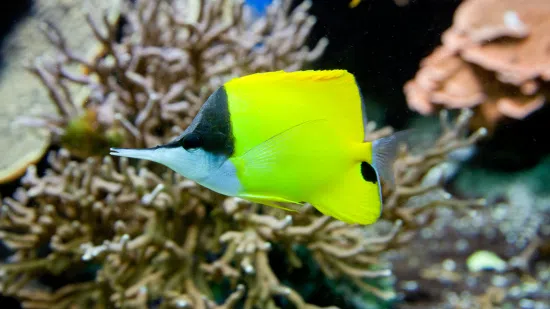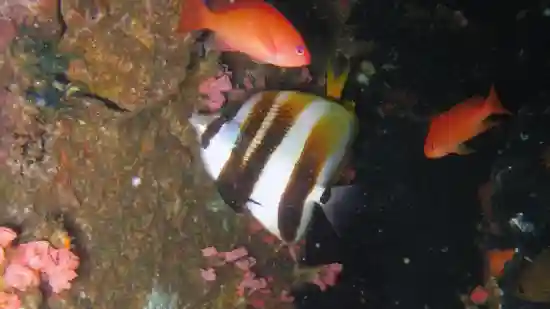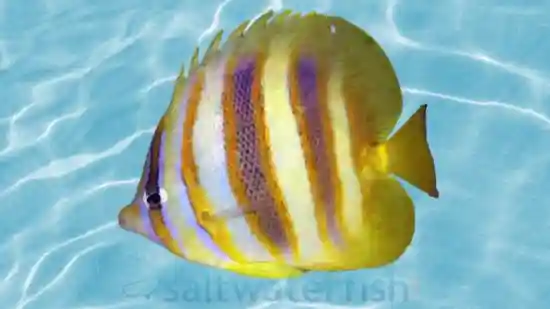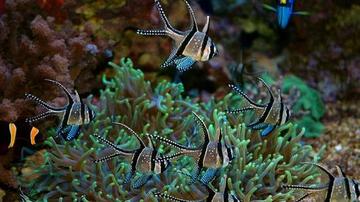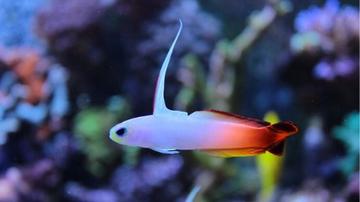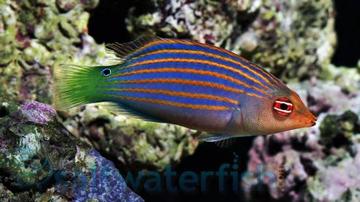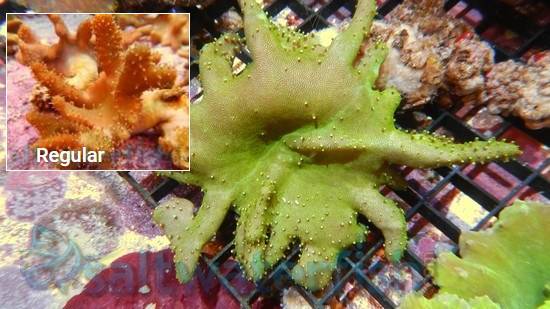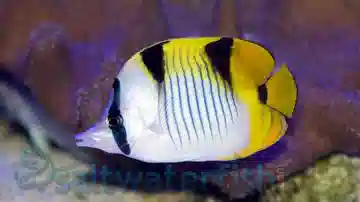Double Saddle Butterfly
Chaetodon falcula
(1 Reviews)
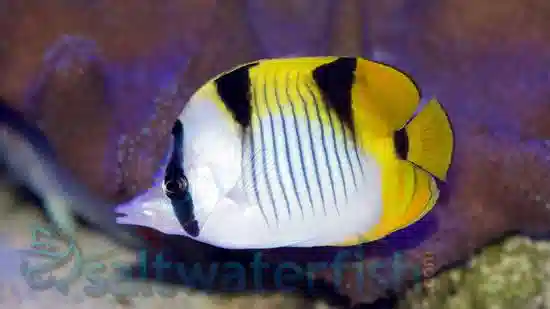
Double Saddle Butterfly
Chaetodon falcula
(1 Reviews)
{{ item.name }}
Size: {{ item.extra_field_3 }}
${{ getFormattedPrice(item.saleprice) }} ${{ getFormattedPrice(item.price) }}
To join the waiting list, click here
Free Shipping
With
$199.00
or more in Marine Life.
More details...
Double Saddle Butterfly Care Facts
| Care Level: | Moderate |
|---|---|
| Temperament: | Peaceful |
| Diet: | Omnivore |
| Reef Safe: | No |
| Minimum Tank Size: | 120 gallons |
| Max Size: | 6 inches |
Comprehensive Guide to Keeping the Double Saddle Butterfly (Chaetodon falcula) from Saltwaterfish.com
Saltwaterfish.com is proud to present a comprehensive guide on the care and keeping of the Double Saddle Butterfly (Chaetodon falcula), a species highly sought after by marine aquarium enthusiasts. This informative description is designed to aid hobbyists in providing the best environment and care for this fascinating species.
Double Saddle Butterfly Habitat:
The Double Saddle Butterfly is commonly found in the Indo-Pacific region, inhabiting tropical coral reefs and lagoons. Clear waters, abundant coral growth, and a temperate climate characterize its natural habitat. These vibrant underwater ecosystems provide an array of hiding spots, feeding opportunities, and companions for this species.
Double Saddle Butterfly Reef Compatibility:
The Double Saddle Butterfly is not considered reef-safe, making it an attractive choice for FOWLR aquariums. This species primarily feeds on coral polyps, but it usually targets dead or overgrown parts of the coral. Occasional nipping at healthy corals may occur, making it essential to monitor their behavior closely if kept in a reef tank.
Double Saddle Butterfly Size and Lifespan:
Double Saddle Butterflies typically grow to an average size of 6-8 inches (15-20 cm) in captivity. Their lifespan can range from 5 to 8 years with proper care, making them a long-term commitment for aquarium enthusiasts.
Double Saddle Butterfly Diet in Captivity:
Maintaining the health of your Double Saddle Butterfly is crucial, and their diet should replicate their natural feeding habits. These fish are primarily herbivorous and will feed on live rock, algae, and small invertebrates. It is essential to provide a balanced diet by offering high-quality flake or pellet foods formulated for herbivorous marine fish. Supplement their diet with fresh vegetables, such as spirulina, seaweed, and algae sheets.
Double Saddle Butterfly Aquaculture Availability:
Double Saddle Butterflies are not commonly aquacultured. Most specimens available to hobbyists are wild-caught. It's essential to source these fish from reputable dealers who employ sustainable collection methods to minimize the impact on wild populations.
Double Saddle Butterfly Compatibility with Other Fish and Invertebrates:
Double Saddle Butterflies are generally peaceful but may exhibit territorial behavior towards other butterflyfish, especially when kept in pairs. They can coexist with many fish and invertebrates as long as their tank mates are not overly aggressive. As conflicts may arise, care should be taken when introducing them to other butterflyfish of the same genus.
Double Saddle Butterfly Sexual Dimorphism:
Sexual dimorphism in the Double Saddle Butterfly is minimal, with males and females displaying similar external characteristics. Determining their sex is often challenging without observing breeding behavior.
Double Saddle Butterfly Juvenile to Adult Coloration Changes:
Juvenile Double Saddle Butterflies feature a distinctive appearance with two bold, saddle-shaped markings on their back, one near the head and the other near the tail. As they mature, these markings may become less pronounced, and their overall coloration may change. The transition from juvenile to adult coloration can be subtle and vary between individual fish.
Double Saddle Butterfly Temperament:
Double Saddle Butterflies are generally peaceful and have a calm disposition. They can be kept in community aquariums with other marine species, provided the tankmates are chosen carefully to ensure compatibility.
Double Saddle Butterfly Tank Requirements:
To ensure the well-being of your Double Saddle Butterfly, you must meet specific tank requirements:
- Minimum Aquarium Size: A tank with a capacity of at least 120 gallons is recommended to accommodate the adult size of these fish and provide ample swimming space.
- Water Conditions:
- pH: Maintain a stable pH level of 8.1 to 8.4.
- Salinity: Keep the salinity level in the range of 1.024 to 1.026.
- Water Temperature: Maintain a temperature between 75°F to 82°F (24°C to 28°C).
- Water Flow: Adequate water flow is essential to simulate their natural habitat, but not excessive to cause stress.
Double Saddle Butterfly Common Names:
The Double Saddle Butterfly is also known by common names such as the Saddleback Butterflyfish, False Falcula Butterflyfish, or just the Falcula Butterflyfish.
Double Saddle Butterfly Compatible Tank Mates:
Choosing suitable tank mates for your Double Saddle Butterfly is crucial to maintaining a harmonious aquarium environment. Here are five species that can coexist with Double Saddle Butterflies:
- Yellow Tang (Zebrasoma flavescens): While you requested not to include the Yellow Tang, it's worth noting that these two species often share the same habitat in the wild and can coexist peacefully in captivity.
- Firefish Goby (Nemateleotris magnifica): These small, colorful gobies are peaceful and make an excellent addition to a reef community tank.
- Royal Gramma (Gramma loreto): These vibrant, hardy fish are known for their striking purple and yellow coloration and are generally peaceful tank mates.
- Clownfish (Amphiprioninae): Clownfish are known for their symbiotic relationship with anemones and often thrive alongside Double Saddle Butterflies in reef tanks.
- Cleaner Shrimp (Lysmata amboinensis): Cleaner shrimp can help maintain the health of your aquarium by removing parasites from the Double Saddle Butterfly and other tank mates.
Why Choose the Double Saddle Butterfly from Saltwaterfish.com:
Saltwaterfish.com takes pride in providing high-quality marine species to aquarium enthusiasts. When selecting a Double Saddle Butterfly from us, you can expect:
- Healthy Specimens: Our fish are carefully sourced and maintained to ensure their health and vitality.
- Expert Advice: Our team of experts is available to assist you with any questions or concerns related to your aquarium and the care of your Double Saddle Butterfly.
- Sustainable Practices: We prioritize sustainability and ethical collection methods to minimize environmental impact.
In conclusion, the Double Saddle Butterfly (Chaetodon falcula) is a captivating addition to saltwater marine aquariums. With proper care, a suitable tank environment, and compatible tank mates, this species can thrive and provide a visually stunning focal point in your reef tank. When you choose Saltwaterfish.com, you can trust in our commitment to providing healthy, sustainable specimens and the support you need to ensure the success of your aquarium.
A cute, little, lively Double Saddle Butterfly that brings a lot of character to your tank. Seems to play well with others and makes a welcome addition while being an easy keeper.
Reviewed by: Melody Marshall on Sept. 11, 2021


